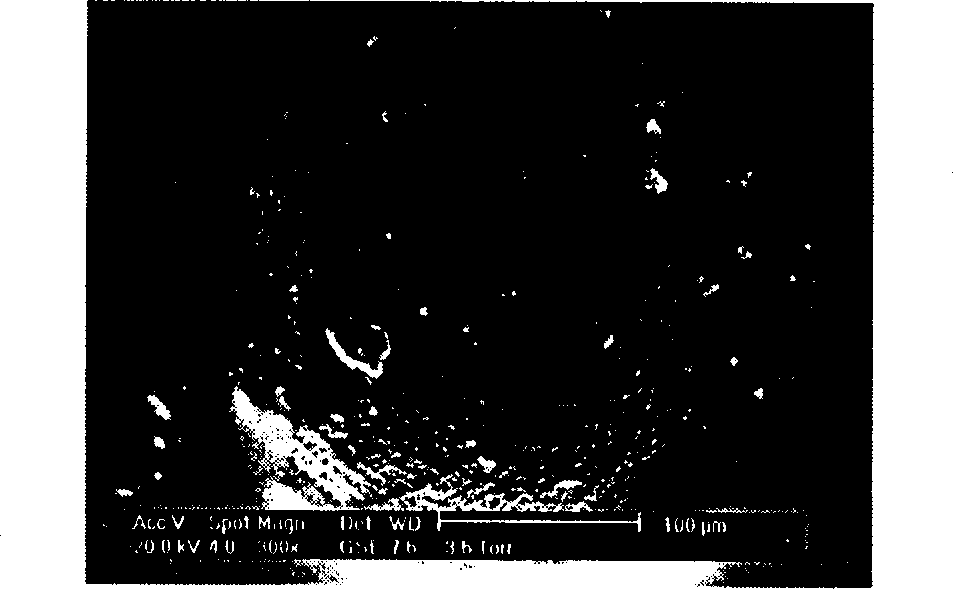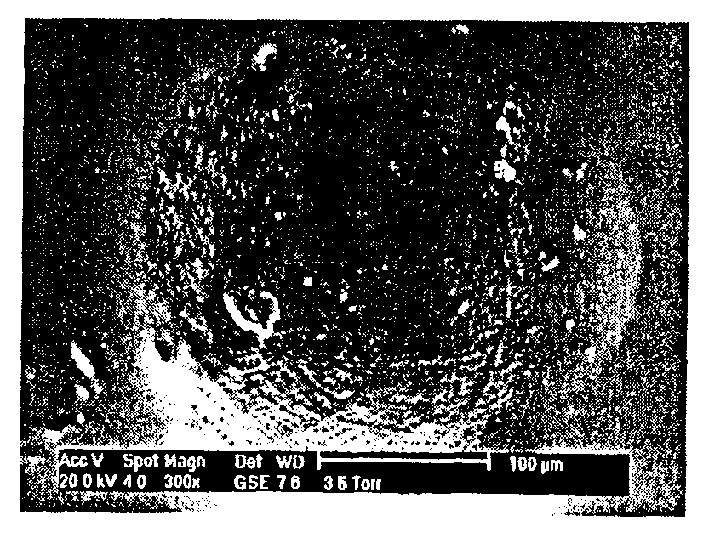Magnetic compound microsphere of blot gel for biological macromolecular template and its reverse-phase suspension polymerization process for preparing it
A technology of magnetic composite microspheres and biological macromolecules, which is applied in the fields of material science and engineering and bioseparation engineering, can solve the problems of limited swelling of template-imprinted gel composite microspheres, and achieves easy coating, mild copolymerization conditions, and broad application. Foreground effect
- Summary
- Abstract
- Description
- Claims
- Application Information
AI Technical Summary
Problems solved by technology
Method used
Image
Examples
Embodiment 1
[0042] 1. Preparation of bovine serum albumin template imprinted gel composite microspheres
[0043] Add 100ml of toluene to a 250ml three-neck flask equipped with a stirrer and vent tube, add 0.2g of ethyl cellulose, and stir to dissolve it. Add 9gAM, 1g Bis and 0.0330g bovine serum albumin (BSA) into 20ml water, dissolve and add 0.2g ground magnetic Fe 3 o 4 Powder, stir and disperse evenly, add to the three-necked flask, continue to stir; dissolve 0.1g of potassium persulfate and 0.05g of sodium bisulfite in 10ml of water, and drop into the three-necked flask. Nitrogen was passed through to remove oxygen, and the reaction was carried out at room temperature for 2 hours. After the reaction, the organic solvent part was filtered out with a 180-mesh screen to obtain BSA template imprinted gel composite microspheres.
[0044] 2. Elution of bovine serum albumin
[0045] After the prepared template-imprinted gel composite microspheres were washed with acetone, they were washe...
Embodiment 2
[0048] 1. Preparation of lysozyme template imprinted gel composite microspheres
[0049] Add 100ml of toluene to a 250ml three-neck flask equipped with a stirrer and vent tube, add 0.2g of ethyl cellulose, and stir to dissolve it. Add 9gAM, 1g Bis and 0.0144g lysozyme to 20ml water, dissolve and add 0.2g ground magnetic Fe 3 o 4 Powder, stir and disperse evenly, add to the three-necked flask, continue to stir; dissolve 0.1g of potassium persulfate and 0.05g of sodium bisulfite in 10ml of water, and drop into the three-necked flask. Nitrogen was passed through to remove oxygen, and the reaction was carried out at room temperature for 2 hours. After the reaction, the organic solvent part was filtered out with a 180-mesh sieve to obtain the lysozyme template-imprinted gel composite microspheres.
[0050] 2. Elution of lysozyme
[0051] After the prepared gel composite microspheres were washed with acetone, they were washed repeatedly with distilled water. Then soak it in an ...
Embodiment 3
[0054] 1. Preparation of Ovalbumin Template Imprinted Gel Composite Microspheres
[0055] Add 100ml of benzene into a 250ml three-neck flask equipped with a stirrer and vent tube, add 0.2g of methylcellulose, and stir to dissolve it. Add 9gAM, 1g Bis and 0.0215g ovalbumin to 20ml water, dissolve and add 0.2g ground magnetic Fe 2 o 3 Powder, stir and disperse evenly, add to the three-necked flask, continue to stir; dissolve 0.1g of potassium persulfate and 0.05g of sodium bisulfite in 10ml of water, and drop into the three-necked flask. Nitrogen was passed through to remove oxygen, and the reaction was carried out at room temperature for 2 hours. After the reaction, the organic solvent part was filtered out with a 180-mesh sieve to obtain the ovalbumin template-imprinted gel composite microspheres.
[0056] 2. Elution of ovalbumin
[0057] After the prepared gel composite microspheres were washed with acetone, they were washed repeatedly with distilled water. Then soak it ...
PUM
| Property | Measurement | Unit |
|---|---|---|
| pore size | aaaaa | aaaaa |
| pore size | aaaaa | aaaaa |
| separation factor | aaaaa | aaaaa |
Abstract
Description
Claims
Application Information
 Login to View More
Login to View More - R&D
- Intellectual Property
- Life Sciences
- Materials
- Tech Scout
- Unparalleled Data Quality
- Higher Quality Content
- 60% Fewer Hallucinations
Browse by: Latest US Patents, China's latest patents, Technical Efficacy Thesaurus, Application Domain, Technology Topic, Popular Technical Reports.
© 2025 PatSnap. All rights reserved.Legal|Privacy policy|Modern Slavery Act Transparency Statement|Sitemap|About US| Contact US: help@patsnap.com



